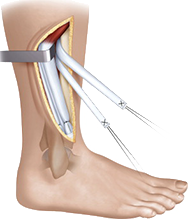Tendon Transfer
#1 South Florida Podiatry Center
 Tendon transfer is a procedure used to restore more normal movement to a foot and ankle that has lost function. While some tendon transfers allow the ankle and foot to move up and down and regain some motion, others bring the foot into a position where it is easier to walk, stand and wear shoes, but will not increase range of motion.
Tendon transfer is a procedure used to restore more normal movement to a foot and ankle that has lost function. While some tendon transfers allow the ankle and foot to move up and down and regain some motion, others bring the foot into a position where it is easier to walk, stand and wear shoes, but will not increase range of motion.
A common problem that requires a tendon transfer surgery is the loss of the ability to raise the foot up, which is called foot drop. This can result from nerve or muscle damage due to stroke or injury.
The main goal of a tendon transfer procedure is the proper alignment of the ankle and foot which can allow the ankle and/or foot to be successfully braced for walking and standing. In some cases, a tendon transfer may eliminate the need for a brace altogether. This realignment can also decrease pain by evenly distributing pressure across the foot.
When is tendon transfer needed
A painful, flexible flatfoot may be an indication for tendon transfer. This develops when the posterior tibial tendon stretches and becomes nonfunctional or ruptures, which can cause the arch of the foot to drop. The patient’s foot then rolls outward and walks on the inside of the foot.
The loss of function of muscles in the lower leg and foot due to a neurological problem is another indication for tendon transfer. This can include weakness after a stroke, nerve damage after a surgery or accident, or a systemic disease causing weakness of the muscles such as Charcot-Marie-Tooth disease.
There are three requirements for tendon transfers to be successful:
- The muscle that the tendon is attached to has to be functional. It must contract at the proper time during walking to do what it needs to do.
- The soft tissue through which the tendon is to be transferred needs to be as normal as possible.
- The joints that the tendon crosses need to be both mobile and stable.
If you have any additional questions or concerns, contact our South Florida foot doctor at 954-906-9272 and make an appointment today.
Tendon transfer procedure
Tendon transfers involve the cutting of the tendon at its normal insertion, rerouting it through the soft tissues either around or between the bones of the foot and ankle, and connecting it to another bone in the foot. When the transferred tendon is long enough, it can be passed through a tunnel drilled through the target bone and then sewn to itself.
The tendon can also be brought into a bone tunnel and fastened with a screw made of either metal or an absorbable plastic. An anchor with sutures attached to it can also be placed in the bone at the point the tendon is to be attached and the sutures used to sew the tendon to the anchor. The soft tissues are then closed and the patient is placed in a splint.
If you feel you would benefit from a tendon transfer procedure don’t hesitate to contact our office today for a consultation with a lead podiatrist in South Florida. Schedule an appointment online today.
References:
1. American Orthopaedic Foot & Ankle Society – Tendon Transfers – http://www.aofas.org/footcaremd/treatments/Pages/Tendon-Transfers.aspx
